
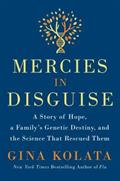 Mercies in Disguise: A Story of Hope, a Family’s Genetic Destiny, and the Science that Rescued Them
Mercies in Disguise: A Story of Hope, a Family’s Genetic Destiny, and the Science that Rescued Them
The Baxely family of South Carolina is a close-knit, religious, civic minded, physically active and well-respected clan with deep roots in Huxley, SC. The Baxely’s also carry a genetic mutant with devastating consequences for each generation.
Prion diseases are neurological, rapidly progressive, and always fatal. Gerstmann-Straussler-Scheinker (GSS) disease is a prion disease that causes rapid degeneration of the cerebellum. Symptoms are spasticity, loss of speech, cognitive dysfunction (similar to dementia) and general degeneration of mental and physical faculties. The disease usually hits between ages thirty to fifty.
New York Times science writer Gina Kolata traces the scientific discoveries and developments leading to the identification of the mysterious and baffling prion diseases. The story of the Baxely family is told parallel to the science giving this read a very human perspective.
Of the four Baxley sons, two of them are neurologists. A casual comment from an acquaintance during the funeral of the Baxley patriarch sparks son, Dr. Tim Baxley’s, search for answers. It begins with a genetic family tree, “… to establish the transmit ion of disease through generations of Baxleys…” The struggle between denial and acceptance of their genetic inheritance is both tragic and admirable. Kolata describes the personal suffering endured by victims and families of victims forced to endure the slow, and devastating progression of GSS.
Scientists in different parts of the world are simultaneously studying the links between prion diseases, via the incredibly slow, laborious process and competitive nature of scientific research. Eventually this process leads to a test that can identify the mutant gene. Baxley granddaughter, Amanda, must decide whether to be tested for the gene. She is challenged with psychological and ethical issues involving marriage, children and her own death. What should she do if she tests positive knowing the potentially devastating effects of her genetic legacy?
Kolata gives the reader a glimpse into the brave new world of genetic screening, counseling, medicine and research. This field has great possibilities for humanity, but carries with it many ethical issues such as privacy, consent, discrimination and social engineering. At 262 pages and written in easily understood terms, this would make a wonderful book group pick.
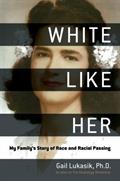 White Like Her: My Family’s Story of Race and Racial Passing
White Like Her: My Family’s Story of Race and Racial Passing
White Like Her: My Family’s Story of Race and Racial Passing is the story of author Gail Lukasik’s very secretive family past.
As a young girl growing up in Ohio, Gail Lukasik was puzzled by her mother Alvera’s quirky habits - wearing makeup to bed, only going outside with wide brimmed hats, long sleeves and pants, refusal to talk about her family in New Orleans, and her nonchalant attitude about her lack of family photos.
Not one photo of Gail’s grandfather Azemar Frederic existed in their home. After 40 years with no answers about who her mystery grandfather was, Gail began her genealogy research journey. This led her to a census record from 1940 for her grandfather, and under his race was the designation, “B”. Knowing this must be a mistake, Gail does more digging and sends away to the State of Louisiana for her mother’s birth certificate, and it reads “ Alvera Frederic (col)”
Still not satisfied, Gail writes to the state of Louisiana for clarification, to which they confirm that ‘col’ next to a name, at that time, meant “colored” or black.
When Gail has enough evidence and courage, she confronts her mother, who after 50 years of keeping her secret says, “How will I hold my head up with my friends?” Alvera's own husband, who was overtly racist, died never knowing the truth of her race.
For those unaware of the term “passing”, a term more commonly used in African American culture, passing is actually the act of racial passing. Typically, a person who passes is an individual of African American or mixed race heritage with a fair complexion and European looking features, who chooses to leave behind their family, friends, community, culture and history, to pass as a caucasian person.
Alvera makes Gail swear to keep her secret until after her death, and she does, for over 20 years. After Alvera’s death, Gail appears on Genealogy Roadshow with Kenyatta Berry (Season 2 - St. Louis Public Library), and learns not only that her mother was listed as Negro on federal census, but that her mom’s mother and father are listed as mulatto and black, respectively.
In this book we follow Gail on her journey of self discovery and her extensive genealogical research. This is especially interesting for those who are interested to learn about the nuances of genealogy as it pertains to race.
In this book we learn about the 1 drop rule, and the 1/32 rule, which were federal laws (Racial Integrity Act -1924) enforced mostly by Southern states that stated that a person with any African Ancestry will be classified as black. Prior to the one drop rule, there were laws designating an individual as black if they had 1 black grandparent, and later changing to include those with at least 1 black great-grandparent. These laws were even more far reaching than similar tactics Nazi’s used to determine an individual as Jewish.
Also of note in this book are the history of enslaved Native Americans in Louisiana, beginning in the early 1700s. I had no clue!
Terminology of interest: Mestizo, quadroon, octoroon, placage, and Gens de Couleur Libre.
In Louisiana specifically, during the earliest days of the colony, and through just before the civil war, there were 3 designations of race. White, Black, and Free people of color (Gens de Couleur Libre). Free people of color included people known then as mulatto, black, Native American, and mixed race people of any combination of European, African, Native American, mestizo, and mulatto. As time passed, free people of color intermarried with other mixed raced free people of color and Caucasian people so much so that the races in Louisiana could never truly be binary. Free people of color may not have had a fully black relative for generations, nor could they live in a completely white society. They were in the middle, a product of both sides, but unable to claim either.
Placage is also a term familiar to some who are versed in Louisiana genealogy, and new to others. Placage comes from the French term “to place”, or “placement”. Placage marriages were common in Louisiana during and after slavery, when interracial marriages were illegal (Finally federally legal in 1967). In a placage marriage, a white man enters into a relationship with a free person of color, sometimes a former slave of theirs, and have a sort of common-law marriage with children who are termed “natural” (who can inherit from their father) rather than “bastard” (who cannot). Sometimes these placage marriages are in addition to legal marriages these men have with their Caucasian wives. And, sometimes they are the only option for a white man who loves a black or mixed race woman and wants to do as much as they can to legitimize their mixed race children, during a time when no matter the dedication and love between parents, mixed race children are legally illegitimate.
This book was great, and it also has really great photos you can reference and see for yourself how Alvera looked! The foreward was written by Kenyatta Berry, and she was amazing, as always.
If anyone else is interested in reading more about racial passing, I recommend Passing by Harlem Renaissance novelist Nella Larsen.
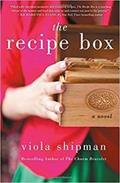 The Recipe Box
The Recipe Box
Traditions, stories, and heirlooms are handed down from one generation to another. These memories keep our histories and heritage alive. The Recipe Box by Viola Shipman is a wonderful example of how years of collected recipes can hold family memories. Through the process of making food, family can share an experience, while partaking of a memory brought about by smells and taste.
Sam Mullins grew up on her family’s apple orchard in Northern Michigan. On her thirteenth birthday, Sam received a recipe box from her mother and grandmother, just as they had received from their mothers on their thirteenth birthdays. After college, feeling trapped by the life of the orchard, Sam moves to New York to start a career as a baker where life does not turn out as she hoped. Returning to the orchard, Sam discovers her life path with the help of her mother and grandmother, and the memories that come alive when recreating generational recipes found in the recipe box.
While this book is a work of fiction, the author, Wade Rouse, honors his grandmother by writing under her name. Her stories and family treasures inspired him to write about family, tradition, and history. Two more novels, The Charm Bracelet, and The Hope Chest also carry the wealth of family memories penned by the author.
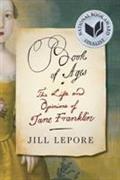 Book of Ages: The Life and Opinions of Jane Franklin
Book of Ages: The Life and Opinions of Jane Franklin
Book of Ages: The Life and Opinions of Jane Franklin by Jill Lepore is part biography, part history, but mostly it is the genealogy of an 18th century woman and her family.
Jane Franklin (1712-1794), a Colonial woman, was Benjamin Franklin’s youngest sister.
While her brother was able to escape poverty, and rise socially and politically, Jane remained trapped by her gender and lack of education. Her one advantage was that through their correspondence, she learned to write, and this ability enabled her to leave behind a roadmap of her life. Though letters to her brother, she records her family’s history, their births, lives and deaths, and creates a canvas of the unknown family members of a famous historical figure.
We learn that Jane’s life was fraught with hardship and sorrow, yet she remained voraciously curious, witty, gossipy, and socially aware. She borrowed books and newspapers, was informed about local affairs, and was always watching for news of her brother. She treasured the books Ben Franklin sent to her and even critiqued some of them in her letters, which is remarkable for a woman of her status.
Jane, the budding feminist, is a delightful surprise in the book. She discusses women’s rights in her letters to her brother, mentioning that the Continental Congress and the writers of the Constitution should, as Abigail Adams also famously wrote to her husband "consider the ladies."
The appendix, the notes, genealogies, a calendar of letters, and Jane’s description of her library collection, take up nearly half the book. From a historical and genealogical standpoint, they are as interesting as Jane’s writings to her famous brother about the family’s lives.
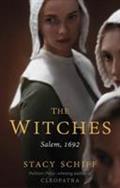 The Witches: Salem, 1692
The Witches: Salem, 1692
One of the reasons genealogy is interesting is because it is historical research at its core. When we find ancestors of ourselves or others, we see them placed them cities, towns, nations and eras of the past. We might wonder how we would have fared in the same circumstances that an ancestor faced, be they times of famine, war, emigration, slavery or political upheaval or times of plenty, peace and prosperity.
I have even found that I have a lifelong fascination with places where my ancestors were from—before I even know that was true, I was fascinated by them. As a child I wanted to know all about New England though I would never set foot there until I was 21. I was specifically interested in Massachusetts and everything about the colonial era. In time I learned that I had many ancestors there, some of who founded the towns of Salem and neighboring Beverly.
I’ve read a lot about the Salem Witch Trials, so it’s hard for me to find a book that really offers anything new, but I think Stacey Schiff’s The Witches: Salem, 1692 is the best book on the subject. She puts the events into a narrative time line so that we see the trial’s progress each day. Her detailed research reveals daily life. Most books about the event do not delve deeply into the quotidian details of the Puritans, but this book does. For instance, I didn’t know that towns in Puritan New England had taverns and that people made it a habit to visit them in the evenings. She has uncovered conversations that people reported to have had in taverns after the day’s trial, for instance. One gets a whole picture of the town, showing how everyone reacted to the events, including many skeptics. The picture is a holistic view of both colonial life and of an extraordinary event.
The book is a history book and therefore it does have its dry moments. But if you like history, and like to read non-fiction, as I do, this book is recommended.
Do you have ancestors from Massachusetts? That might make The Witches even more interesting to you.
Stacy Schiff won the Pulitzer Prize for her book, Cleopatra. For more about the book: http://www.stacyschiff.com/the-witches-salem-1692.html
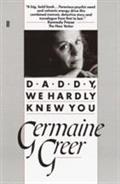 Daddy, We Hardly Knew You
Daddy, We Hardly Knew You
Daddy, We Hardly Knew You is by well-known feminist writer, Germaine Greer. Her best-known book is The Female Eunuch, published in 1970, which made her a household name at the time. This book is also available through the OC Public Libraries website via Hoopla.
This is the fascinating story of Greer’s hunt for the true history of her father, Eric Reginald (Reg) Greer, and his ancestry. The search required travel to India, England, and Northern Ireland, as well as within her native Australia. She enlisted the help of genealogists and spent thousands of dollars before she found the truth.
Reg Greer, according to his own story, was born in Durban, South Africa to English parents who were en route to Australia by way of South Africa. Reg turned out to be quite an adept embellisher and fabricator of truths that gave his unknowing wife and children a much more illustrious impression of his history and ancestry than was eventually revealed—beginning with the fact that he was not Eric Reginald Greer. Luckily for his daughter, Germaine, his stories contained just enough truth to track him down.
During her search, Germaine Greer became an expert on the history of the Greer family line—an ancient line tracing its origin to the McAlpine Scottish clan—descendants of whom can be found in Northern Ireland (Ulster) and Great Britain, and who also immigrated with Quakers to Pennsylvania, and to South Africa and Australia. The truth ends up laying much closer to home, in the place where Germaine and her family grew up, on the island of Tasmania, in Australia.
The genealogical hunt unfolds largely within the backdrop of detailed descriptions of the island and of the local town of Launceston (with the exception of sections describing her father’s time spent in the Australian service during WWII in India—maybe—in Egypt, and on the island of Malta).
As she tells her story, Greer also examines her complex relationship with her father, who largely ignored her most of her life. Greer’s background in literature includes a PhD from Cambridge University, so it is not surprising that the text is peppered with quotes from well-known writers, including poets such as Sylvia Plath and Hart Crane. I found this story well-written, fascinating from a genealogical research perspective, and highly satisfying in its own right as a work of memoir.
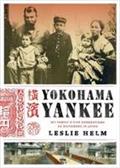 Yokohama Yankee: My Family’s Five Generations as Outsiders in Japan
Yokohama Yankee: My Family’s Five Generations as Outsiders in Japan
When Julius Helm arrived in Yokohama in 1869, Japan had but recently emerged from 200 years of self-imposed isolation. The country was eager to modernize, and opportunities abounded for foreigners with desirable skills. Julius proved to be up for the challenge. The business he founded became the largest foreign-owned stevedoring company in Japan and “Helm” a household name in Yokohama. Excerpts from journals, as well as interviews, photos, and contemporaneous woodblock prints flesh out this account of 5 generations of a German-American-Japanese family.
Julius had seven children with his Japanese wife Hiro. The family lived in the foreign settlement in Yokohama, where Japanese authorities had no jurisdiction. For the next century and a half, through two World Wars and two disastrous earthquakes, the family continued to live as expatriates in Japan, intimately connected with—yet separate from—their country of birth.
The author is Julius’ great-grandson. As a correspondent for the Los Angeles Times he notices a persistent negative tone to his reporting about Japan, leading him to delve into his family’s history. The ambivalence and confusion he feels towards Japan are compounded when he adopts two Japanese children, and their struggle to become a family brings the narrative full-circle.
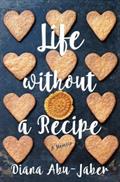
Life Without a Recipe: A memoir
Genealogical research doesn’t have to be all about DNA, obituaries and ship registries—food also tells an important story. The flavors we blend and recipes we make are fun ways to share a bit of family heritage along with the usual branches of a family tree. Diana Abu-Jaber’s memoir Life without a Recipe is a perfect example of this. Beginning with her earliest memories caught between a German grandmother’s baked goods and her Jordanian father’s savory dishes as they vied for her alliance with their values and ideals, this book leaves no culinary stone unturned.
Struggling to find her own path in life, rather than the ones suggested by her grandmother or father, the author goes through two failed marriages before finding that for her, the third time is a charm. There are journeys to far off lands, friends and family taken too soon by serious illnesses, and throughout it all she chronicles the food and recipes that help her celebrate and mourn.
One recurring issue that is present from the first time she cracks an egg into cake batter with her grandmother is the subject of children. Struggling with whether or not they should be a part of her life, the possibility of biological children passes, so she and her husband tackle the difficult route to adoption. When daughter Gracie joins their family, once again it is through food that old memories are shared, new ones are created, and a family heritage grows a little more.
 Hillbilly Elegy: A Memoir of a Family and Culture in Crisis
Hillbilly Elegy: A Memoir of a Family and Culture in Crisis
Earning the Rockies: How Geography Shapes America’s Role in the World
I wasn’t keen on reading Hillbilly Elegy and I think that’s because of the subtitle. It sounds sociological, but it really is just one person’s family story. An elegy, too, implies death, but it’s a hopeful book and ultimately about resilience. The writer’s voice sounds like he’s talking to you, in clear and unadorned prose, and he tells his particular story with a keen observation and insight about drug addiction, violence, poverty, and the migrant’s journey from Kentucky to Ohio on a path sometimes called “The Hillbilly Highway.” Like many others from Kentucky, most of his mother’s immediate family and his grandparents moved to Ohio and Indiana to find work. They lived in Ohio most of their lives but never lost their unique Kentuckian outlook—a colorful, individualistic, caring, and sometimes tragic way of life. They visit Kentucky often and the author describes how the so-called “hillbilly highway” is crowded with Ohio license plates going back to visit Kentucky during Thanksgiving weekend. It is an elegy, though, for the author’s childhood and his young adult life in Ohio and Kentucky, which he leaves behind him. He describes his experience going to Yale Law School, and what he learns there is not just the study of law, but the behaviors and habits necessary for assimilation into northeastern, upper middle class culture. It is a bittersweet book.
These habits of assimilation are ones faced by all of our ancestors, as they came here and saw their language and habits lost by their children’s or grandchildren’s generations. So too the moves around the United States for land or work changed people as they took on different habits, values, faced prejudices or welcomes, and even as they experienced new weather, whether they were seeking gold, oil, jobs, improved living conditions, or were relocated by stints in the armed forces.
Earning the Rockies: How Geography Shapes America’s Role in the World by Robert D. Kaplan examines different parts of the country and why they are either thriving or dying. His thesis is that a place now must have a connection to the international community, whether through business or education, in order to thrive.
Citizens move because of changes in circumstances, the loss or gain of jobs, and the promise of better opportunities for them and their children. So too did our ancestors move for these reasons. The loss of place and adjustment to a new one is the story and the history behind the migration of many of our ancestors.
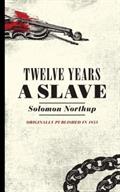 Twelve Years a Slave
Twelve Years a Slave
176 years ago, a free man born and raised in New York, husband and father of three, traveled to our nation’s capital with the promise of lucrative work, only to be kidnapped and sold into slavery, eventually ending up in Louisiana. That fateful day in 1841 began a twelve year ordeal in which he was separated from his family, submitted to harsh and inhumane conditions, and tested to the uttermost depths of his character. This man was Solomon Northup, and his story is told in his autobiography, Twelve Years a Slave.
In 2013, this book was made into a critically-acclaimed movie, the first major fact-based motion picture about the slave experience in America, and now new light has been shed on the original haunting text. Seeing the movie may have you conclude that you have finished his story. You would miss, however, one of the most amazing pieces of slave narrative to come down to us today. Not only does it highlight the cruelties and nuances of the Louisiana slave-owning culture, the social subtleties and complexities of slavery in our nation in the decades running up to the Civil War, and the Reverse Underground Railroad, but it gives genealogical details vital to the person searching during that time period. It is a treasure trove of information. He gives details of people who lived in the Avoyelles Parish area of Louisiana, not only the slave owners who most assuredly made it onto censuses, but also the slaves, what names they went by, naming conventions, where they were from, and the details of their particular story (and each story is so unique). He gives details on the music, food, customs, language, and the everyday life of the people. The book takes you back to that time and allows you to step into his shoes in a vivid way. From this vantage point, it also highlights the many shades which make up our common culture.
Twelve Years a Slave is difficult to read because of the trials and travails Solomon and his fellow slaves underwent, but it is an invaluable witness to the experience of untold men, women and children kidnapped and sold into slavery—as well as the millions of other victims of slavery who never knew freedom at all. This is, in part, what genealogy is about—giving voice where there was none before. The history of our families and culture are kind of like the old maps with extreme detail in some places and nothing in other places. Twelve Years a Slave gives everyday details to the slave experience, which history for the most part has left us a whole lot of blank space on the map.
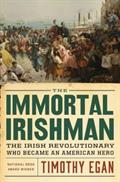 The Immortal Irishman: The Irish Revolutionary Who Became an American Hero
The Immortal Irishman: The Irish Revolutionary Who Became an American Hero
Timothy Egan’s The Immortal Irishman, is the epic biography of Thomas Francis Meagher. The author closes the book’s introduction stating that “his life is the story of Ireland.” It is an excellent read, with an almost poetic cadence, which combines Irish and American history. Egan’s vivid, and fascinating focal elements, aptly enmesh the life of one man with the history, genealogy, and struggles of the Irish. Born in 1823, Meagher was raised in comfort. His father, a wealthy merchant from Waterford, held a seat in the British Parliament and embraced safe politics. His son’s political leanings proved to be different. Thomas Meagher was sent to a Jesuit boarding school to study. Instead, he was radicalized by the potato famines, and he joined the Young Ireland independence movement. After school, he studied law at Trinity College, but he was mostly involved in politics. He spoke five languages, and enjoyed powerful oratory skills, which he exercised effectively during the Great Famine of the 1840s.
At age twenty-six, Meagher escaped a death sentence, following the failed Young Ireland Rebellion of 1848. He was instead exiled to Tasmania, later escaping to New York with his father’s assistance. In New York he became an instant celebrity for championing democracy, and had fan clubs across the country. Meagher’s good looks, charm, and powers of persuasion were not lost on women. Over her father’s objections, he married a daughter of one of New York’s most prominent families. He had previously married while in exile in Tasmania. His pregnant wife traveled to England to give birth to their child, after he escaped. The child did not survive, and the wife eventually died there.
Among the many Irish immigrants who had fled the famine, Meagher found a following for his political ideology. When the Civil War broke out, many became his foot soldiers. Meagher’s unattainable dream was to have his group return to Ireland to fight the English. His command was the 69th Infantry of the New York militia, known as “The Irish Brigade,” a group so determined to hold their ground, that they were nearly decimated in the Battle of Fredericksburg. Meagher himself was shot off his horse twice while leading charges, and was left for dead in Virginia. Egan’s talented prose saves the war scenes from being utterly morbid. He describes Meagher falling into despair, and turning to drink, appalled by the “acres of slain and dying,” and his disillusionment with his subordinates, who were not willing to accept the idea of freeing the slaves, fearing for their jobs. After Fredericksburg, Meagher resigned his commission, and later served in the West, becoming the acting governor of Montana Territory in 1866.
Meagher disappeared in 1867, and various hypotheses as to the cause of his death circulated at the time. It is now believed that he was murdered, and members of the Committee of Vigilance, which enforced its own lawless version of law and order, are likely candidates. Despite his many successes and admirers, he was a man with enemies throughout his eventful life.
In 1905, an equestrian statue of Meagher was erected at the Montana state capitol in Helena.
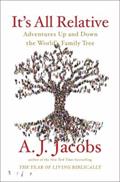 It’s All Relative: Adventures Up and Down the World’s Family Tree
It’s All Relative: Adventures Up and Down the World’s Family Tree
We are all cousins! In fact, according to author A. J. Jacobs (A Year of Living Biblically, Drop Dead Healthy, and The Know it All) we are one great big global family. In his latest book, It’s All Relative: Adventures Up and Down the World Family Tree, Jacob suggests that we are all related in some way—think six degrees of separation. Believing that this might be the path to world peace, ending war and racism, he encourages readers to participate in such sites as Geni, Family Search and WikiTree. These collaborative websites have millions of participants attempting to create a giant “World Tree.” Yup! We are one great big (dysfunctional?) family.
Jacobs went so far as to throw a Global Family Reunion in June 2015. Held at the New York Hall of Science in Queens, New York, there were 3,700 attendees. With an appearance by Sister Sledge singing ‘We Are Family” and with Louis Gates Jr. and CeCe Moore as speakers, the author calls it “the best worst day of his life.” He traces the evolution and stress of planning this event with a series of “count down” notes at the end of each chapter.
Jacobs takes the reader on a light-hearted, humorous tour through the latest genealogy discoveries, studies and events, including lots of anecdotal examples from his own family and acquaintances. He discusses twins, adoption, migration, DNA, tribalism, and family secrets revealed. Jacobs interviews and quotes such notables in the field as David Allen Lambert, McKeldan Smith, and Eowyn Langholf plus many more. He includes solid research, good advice and pages of resources for the budding genealogist.
According to USA Today, genealogy is now the second most popular hobby in America. Following this trend, Jacobs introduces readers to this fascinating and addictive world of discovering “who” we are in a way that is entertaining and easily digestible.
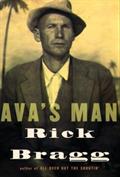 Ava’s Man
Ava’s Man
I first read Rick Bragg’s Ava’s Man when it was published in 2002. It is the biography of his maternal grandfather, Charlie Bundrum, who grew up and lived in the Appalachian foothills, in towns straddling the Alabama and Georgia state line, before and during the Depression.
Charlie died before the author was born, and Rick Bragg pieced together the book from stories gathered from his mother, grandmother, aunts and friends, to create a powerfully gritty family history, told in a lyrical Southern dialect, and shows why his grandfather, despite his failings, is a legend in his family.
Bragg describes a good man and his family doing their best to survive during the Depression, and explores their experiences through the memories and lives of Ava and Charlie, their ancestors, and children. Charlie never owned land or a house. He was illiterate, but asked his wife to read the paper to him every day, so “he would not be ignorant.” Most of all, Charlie was not boring, but rather was larger than life. He played the banjo, sang, and danced. He also liked his “likker,” but unlike many, he was not a mean drunk. His wife was tough, as I am sure she had to be, but she too loved her man.
He worked mostly as a carpenter and roofer, and traded labor for food, when paid work was not available. He was a decent husband and a good father, who loved his children and grandchildren beyond reason, and who in turn adored him. Charlie had a few run-ins with the law, as well as some with criminals; Bragg describes stories of fishing on the river, of friends and strangers picked up and helped along the way, and of Charlie’s comical slip-ups.
Despite living through hard times, the family had a contented, though difficult life, and perhaps because of the overall difficulty of their lives, enjoyed their small pleasures and loves even more. When he died, people of all walks of life crowded his funeral. Charlie pulled his family through the tough times, and his children never wanted to be far from him. He left his family with a legacy of love and kindness after pushing through tough times in the poverty-stricken South, living, loving, and working through the hardships of life with dignity and humor.
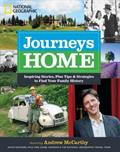 Journeys Home: Inspiring Stories, Plus Tips & Strategies to Find Your Family History
Journeys Home: Inspiring Stories, Plus Tips & Strategies to Find Your Family History
In America, we define our country as a melting pot, as a land of immigrants. So if you are a genealogist in the US, chances are good that your search will lead you abroad at some point. And what better excuse to take a trip abroad (not that I need an excuse!), than to learn about where your family came from?
I was thrilled to find the book, Journeys Home: Inspiring Stories, Plus Tips & Strategies to Find Your Family History, which was published by National Geographic. As the subtitle says, this book will give you some inspiration and motivation on your genealogical journey. And for those who want to take the next step and travel to their countries of origin, it will give you ideas for further reading, show you festivals you might want to experience in your ancestors’ country, and tell you what else you can see (and eat!), if you go there.
Part of the draw of learning about our ancestry is learning about where our forebears lived, what they ate, what they did on daily basis, and what the world around them looked like. Journeys Home is a great way to start this process. The contributors evoke a sense of place—some of the chapters are written by well-known travel writers, including Pico Iyer, Diane Johnson, and Andrew McCarthy. I found that learning about their histories made me want to learn more about mine. Ireland, Vietnam, Germany, Angola, and many other countries are represented.
At the end of the book, there is country-specific research information, including websites you can use to prepare for your ancestral searches, as well as archives, libraries and other places you can visit to find genealogical information after you arrive in that country.
Happy searching and happy travels!
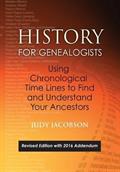 History for Genealogists: Using Chronological Time Lines to Find and Understand Your Ancestors
History for Genealogists: Using Chronological Time Lines to Find and Understand Your Ancestors
History for Genealogists: Using Chronological Time Lines to Find and Understand Your Ancestors by Judy Jacobson is great for getting researchers to make use of the historical events and context in which ancestors lived. This approach is not only a valuable research tool for helping validate the details researchers discover about ancestors, but also in helping to imagine the places and times in which they lived—this is a part of each ancestor’s story that can provide explanations for why an ancestor arrived at a place, chose to stay, or left. And if a researcher runs into an ancestor that seems just to disappear, time lines can sometimes supply clues as to why. Was there a war or some other civil disturbance that may have prompted them to leave the place where they lived? Could they have passed away due to an epidemic in the area? These are the types of questions that time lines may help answer. And this book is full of time lines—and associated interesting narrative related to each time line. There are case studies demonstrating the use of time lines for problem solving. And time lines involving military actions, socio-political events, religion, disease, economics, and natural disaster are all included to help answer the question: Why did they leave? There are chapters on how people moved from place to place, how they came to America—including migration patterns, and state-by-state time lines, just to mention a few highlights. Just the time lines themselves are interesting to read—especially for history buffs!
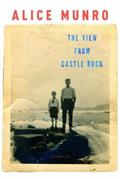 The View from Castle Rock
The View from Castle Rock
There aren’t may titles listed under “Genealogy—Fiction” but one notable exception is this book, The View from Castle Rock, by Nobel Prize winner Alice Munro, short story master.
As she writes in the introduction, these stories form something of a memoir of her family from its immigrant origins in Scotland to her life as a 60-year-old woman. She says these are fictional stories, but they “pay more attention to the truth of a life than fiction usually does.” So while they are fiction, they are informed by the stories she learned of her family and of her research into her family background. These stories are not included in her other collections that she put together, though she wrote them concurrently.
Her ancestors, the Laidlaws, came from the Ettrick Valley, a place of “no advantages” in Scotland. The first part of the book is about their lives. The second part of the book, called “Home” deals with Munro’s childhood, adolescence, and adulthood in relation to where she grew up in Canada. The stories deal with her relationship with her parents and friends.
If you know Munro’s work, then you know that she writes beautiful, lyrical prose and her stories unwind into complex plots with often surprising developments, which always feel true and real.
I highly recommend this book about immigrants and genealogy in fiction.
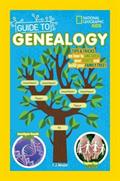 National Geographic Kids Guide to Genealogy
National Geographic Kids Guide to Genealogy
I’m a genealogy buff and a visual learner, plus I’m quite possibly in my second childhood—so it’s no surprise that I found the National Geographic Kids Guide to Genealogy by T. J. Resler to be fantastic!
This Guide to Genealogy is colorful, readable, and well organized, with plenty of kid appeal, but it is not just for kids. Adults, too, can benefit from this (deceptively) thin book. Deceptively thin, because it is quite literally bursting with information. The book contains many interesting tidbits for the genealogically inclined, and may serve to spark an interest in the uninitiated. The book is divided into chapters—Detective Work, Tools of the Trade, Beginning the Investigation, Finding Clues, Hot on the Trail, Filling in the Blanks, and Into the Forensics Lab—each containing subchapters and case files. Timely material on genetics and DNA is also included. A helpful section on genealogy terminology is available in back. Asking (not so rhetorically), “Who are you?”, the guide identifies what genealogists do, and likens some aspects of genealogy, such as finding out “who you and your ancestors are”, to a mystery that you can help solve.
Multiple text boxes, sidebars, varied illustrations and photos complete the presentation. The pages may seem a bit information heavy, but their colorful appearance helps to make ancestor hunting even more engaging. Since there is a lot of material covered, even older children may find that breaking the information down and tackling one topic at a time could work out for the best.
To wrap it up: I love it! It is a volume children (and adults) can happily refer to and learn from.